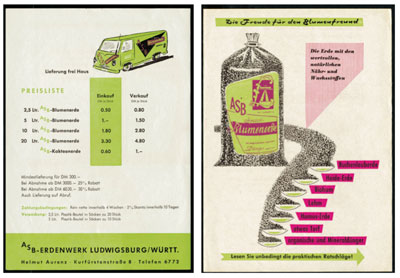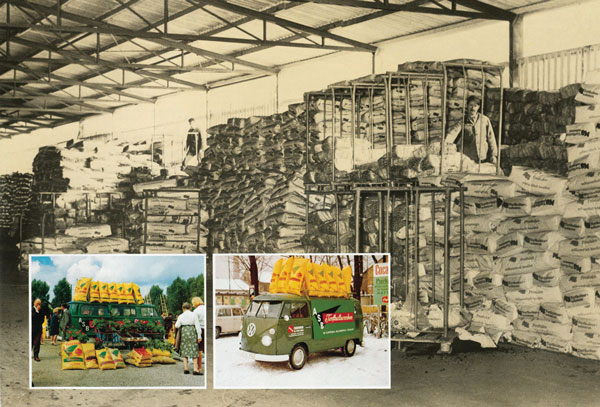7/1/2018
Behind the Business: Potting Mix—It’s in the Bag!
Chris Beytes
Helmut Aurenz didn’t want to be a gardener like his father. After befriending a local photojournalist, who showed him the technical aspects of photography and took him along when he covered the big sporting events in his hometown of Ludwigsburg, Germany, Helmut decided he wanted to be a news photographer.
Born in 1937, Helmut wasn’t as strong or active as his older brother, and so going into their father’s trade of gardening didn’t appeal to him. But father insisted he do “something decent,” and so, starting at age 14, he began the first of several gardening apprenticeships, first in his father’s market garden and later in a potted plant nursery. He also attended vocational school and worked for a local florist.
 Pictured: • The first large production facility in Eisenharz, which opened in 1964 (now closed). You can see the peat bog in the background.
Pictured: • The first large production facility in Eisenharz, which opened in 1964 (now closed). You can see the peat bog in the background.
• Helmut Aurenz, from about the time he started his company. • ASB’s first production plant in Ludwigsburg and Helmut’s first company vehicle.
Helmut learned growing, but he found he had a knack for “trade”—for selling and marketing. He also developed an interest in the soils and composts used in the gardens and nurseries. In one of his apprenticeships, he and the other apprentices had to rake leaves and compost them with the addition of calcium nitrate, then distribute the compost into cold frames for the growing of young plants.
Now, here’s the thing about potting compost back in the 1950s: there wasn’t any—not blended, anyway—and certainly not bagged and available commercially. If you needed some for your own garden, you bought it by the bucketload from a local nurseryman or gardener … who more than likely needed it for their own plants and didn’t want to part with it.
Helmut, noting this supply-and-demand situation, began filling 5-liter bags with compost, carrying them five at a time on the train to the florist shop. They sold quickly.
 In 1958, with an umbrella for a roof, a wheelbarrow, a shovel and a sieve, Helmut officially started his own business mixing and bagging compost. He built his first “office” (a shed) on the property of the garden where his father worked. His raw materials were clay soil, peat, calcium and leaf compost, which he blended into the first premixed, bagged potting mixes commercially available (at least in Germany).
In 1958, with an umbrella for a roof, a wheelbarrow, a shovel and a sieve, Helmut officially started his own business mixing and bagging compost. He built his first “office” (a shed) on the property of the garden where his father worked. His raw materials were clay soil, peat, calcium and leaf compost, which he blended into the first premixed, bagged potting mixes commercially available (at least in Germany).
Pictured: A price list and advertisement from 1958, the year ASB was founded.
He gradually enlarged and enclosed the shed, then purchased his first processing machine and a truck. He sold his bagged mix at local produce markets and grocery stores, with whom he had contact from his days selling vegetables with his father. This eventually grew to include the large chain stores.
Demand for his bagged mix was tremendous and growth was rapid. By 1960, he’d outgrown the shed and built his own small production plant. By 1962, he’d bought his first raw materials source, a marshland in Eisenharz, about three hours to the south, near the Austrian border. He moved his company there in 1964.
Over time he added more production capacity and more raw material sources, both in Germany and abroad, in Estonia on the Baltic coast, the Czech Republic and Canada. He added plastic film production and printing capabilities so he could manufacture his own packaging. He added liquid fertilizers to the line and even opened a chain of garden centers. In 2008, Helmut turned management of the company over to his daughter, Michaela Aurenz Maldonado. Today, the company’s 60th anniversary year, they have nine production plants and nine sales offices in eight countries.
What of the company name?
ASB stands for “Aurenz Spezial-Blumenerde” (Aurenz Special Potting Compost). ASB was the original name of the business, with a simple logo designed by a local artist whom Helmut had hired to do advertising art.
 Pictured: Business boomed in the 1960s, thanks in part to clever marketing, such as this VW van mobile display unit.
Pictured: Business boomed in the 1960s, thanks in part to clever marketing, such as this VW van mobile display unit.
Grunland was added to the name in 1981 when ASB acquired the Grunland brand of fertilizers, pesticides and herbicides. It was changed to the English translation Greenworld to reflect the global nature of the company (which had opened its first American office the same year and its Canadian office the prior year).
For someone who didn’t want to go into gardening, Helmut certainly influenced the gardening world! And he was well recognized for it. He’s been invited to serve on numerous corporate boards, including Audi and Lamborghini (now VW) and Scania trucks. He was named an honorary “senator” by the University of Hohenheim and was appointed Honorary Consul to the Republic of Estonia. He received that country’s Distinguished Service Cross in recognition of his contributions and commitment to Estonia and its people in both economic and humanitarian terms. There’s even a lecture room named for him at Valdosta State University in Georgia (where ASB Greenworld once had a production facility).
As for Helmut’s boyhood desire to be a photographer? Well, it didn’t completely go by the wayside. As a serious hobbyist, he amassed a large collection of cameras. And he documented much of ASB Greenworld’s growth, which could be one reason there’s such a good collection of historical photos in the company archives (from which these photos were sourced). GT